The Nexus 7 (2013) Review
by Anand Lal Shimpi on August 22, 2013 6:00 PM ESTPlatform Power & Battery Life
The new Nexus 7 moves to a slightly smaller battery compared to its predecessor (15Wh vs. 16Wh). The result however is anything but a reduction in battery life. ASUS and Google worked hard to reduce platform power consumption as much as possible. I instrumented both Nexus 7s and measured total platform power, excluding display, to look at the impact of the silicon platform (SoC, PMIC, DRAM, eMMC, WiFi, etc...). The results are beyond impressive:
Idle power is cut in half compared to last year's model. This is by far the most important improvement as most mobile usage models tend to have long periods of idle time. We'll see these power gains reflected in our web browsing test which does have significant periods of simulated reading time between web page loads. The power reduction while running Kraken grows to just over 20%, and even while running Geekbench 3 we see a 16% drop with the new Nexus 7. Only our offscreen 3D test manages to draw more power on the new Nexus 7 than the old one, and that isn't taking into account the nearly 5x increase in performance on the new Nexus. In fact, as impressive as these numbers are - they are even more impressive when you take into account performance. To make a long story short, don't worry about the ~7% decrease in battery capacity as there are enough improvements in platform power and performance (and thus perf per watt) to more than make up for the smaller battery.
We'll start out with our WiFi web browsing test. Like all of our battery life benchmarks we run this test with all devices calibrated to 200 nits and connected to 5GHz 802.11 WiFi (if supported). The test itself cycles through a bunch of desktop websites at a very aggressive frequency. Our test ensures that both the CPU cores and wireless stack can reach their deep sleep states during simulated reading periods. The test continues until the battery is depleted.
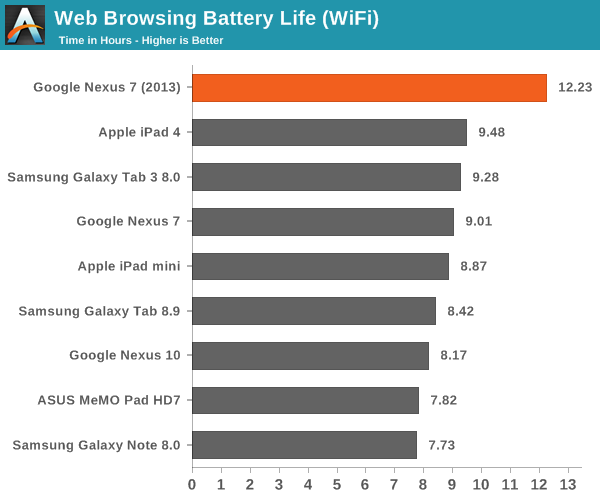
The new Nexus 7 does better here than any other small tablet we've ever tested. Remember that 50% decrease in idle platform power? That's exactly why we're seeing a 35% improvement in battery life compared to the original Nexus 7.
Our video playback test involves looping the playback of a 4Mbps 720p High Profile H.264 transcode of the last Harry Potter Blu-ray. All displays are calibrated to 200 nits.
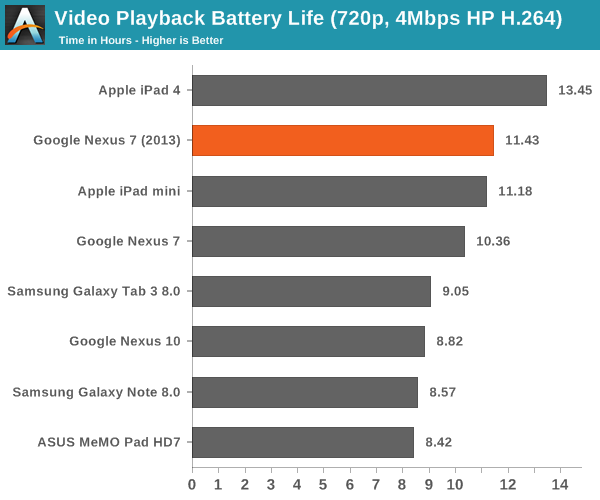
Video decode blocks are fairly well optimized to begin with, so there's not a ton of room for improvement here compared to last year's Nexus 7. Despite the ~7% shrink in battery capacity, the new model manages a 10% increase in battery life though. We also have the first small Android tablet capable of beating the iPad mini in a video playback test here - job well done ASUS/Google.
Our final test involves looping the Egypt HD benchmark until the battery is completely drained. Frame rates are capped to 30 fps to somewhat simulate actual gameplay and not penalize faster GPUs.
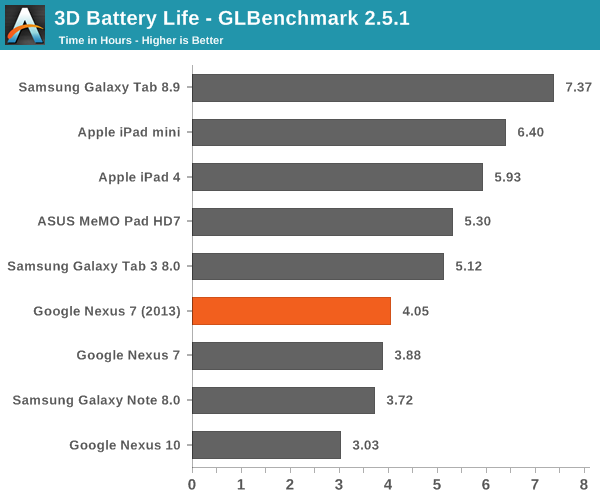
The new Nexus 7 manages to deliver slightly better battery life here despite driving higher frame rates and more pixels. Overall performance here isn't anything super impressive, the only average showing from the Nexus 7.
Google ships the Nexus 7 with an ASUS branded 7W charger, identical to the one you'd find in the box of a MeMO Pad HD7. Given identical chargers and battery capacities, there's no surprise the new Nexus 7 takes the same amount of time to charge as the MeMO Pad HD7 (~3.5 hours).
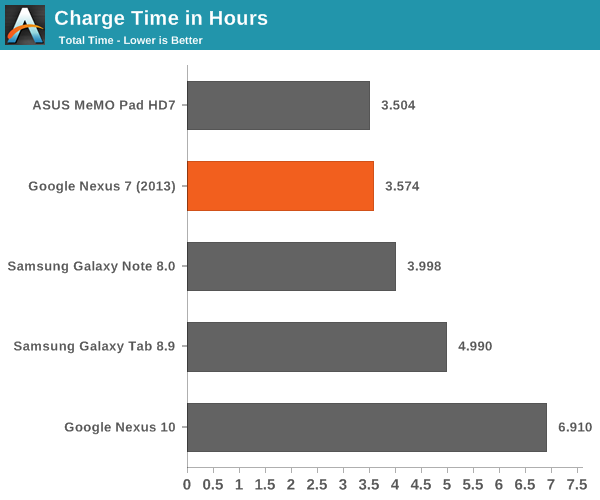
The new Nexus 7 also supports wireless charging by implementing the Qi standard. Charge time is a bit slower wirelessly as Qi can only charge at up to 5W. Brian tested Qi functionality in his mini review of the Nexus 7 and didn't have any issues.


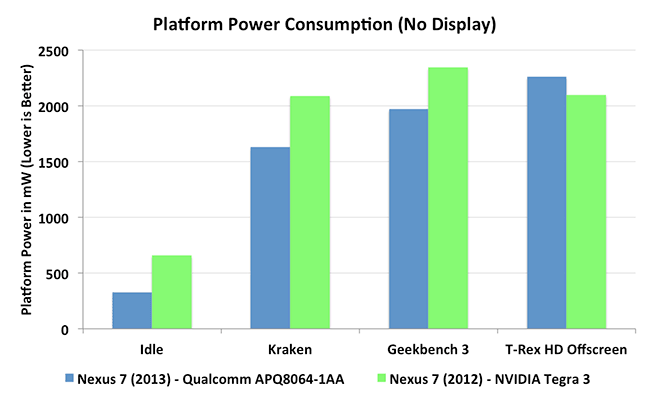









202 Comments
View All Comments
ESC2000 - Wednesday, August 28, 2013 - link
Actually I have. Go look at the picture on the first page of Anand's review. .. the nexus 7 shows a few more lines of the anandtech website than the mini. I'll admit that it should be more if what I said was absolutely true (ie, every the nexus shows 2x more pixels) but even if the nexus doesn't take full advantage of its pixel density, it still beats the ipad mini in how much it shows on the screen in most situations.ESC2000 - Monday, September 9, 2013 - link
You do realize that selling more each iteration does not mean apple isn't losing market share since the tablet market has been growing exponentially... It's the same as how each iPhone sells more than the last but still iOS loses market share each year. If apple sells 5 million iPads in one quarter out of 10 million total tablets sold and then sells 6 million iPads the next out of 20 million sold, apple sold more in the second quarter but lost market share.WarpGuN - Friday, August 23, 2013 - link
in your dreamskascollet - Saturday, August 24, 2013 - link
Please stop spoiling this excellent tech-site. You don't belong here man.jl0329 - Wednesday, October 9, 2013 - link
You clueless dumb shit.KPOM - Thursday, August 22, 2013 - link
The iPad mini is at the end of its product cycle.The Nexus 7 is at the beginning. Let's hold off for a month or so to see what Apple has in store before complaining that Anand didn't compare (no pun intended) apples to apples. True, if you are in the market today, what's on tap for next month is irrelevant, but even the mainstream sites latch on to rumors today, so most people realize that the WSJ/AllthingsD essentially leaked that the iPad is due for a refresh.sherlockwing - Friday, August 23, 2013 - link
A month? I guess you haven't read the recent reports that the Retina Mini is pushed back to early 2014? iOS7 tablet apps is also lagging significantly behind iOS7 phone apps.abazigal - Sunday, August 25, 2013 - link
Those remain unsubstantiated rumours. Besides, the next ipad isn't even announced yet. Expect apps to be rapidly updated once it is announced.EnzoFX - Friday, August 23, 2013 - link
The comparison's to the ipad 4's screen is incredibly welcomed. I wanted the comparison quantified. Color accuracy I care about, the iPad 4 set the bar. There may be no cross-shopping, but for those that want a great calibrated screen, now we have 2 real options.danderson10k - Thursday, August 22, 2013 - link
Another series of Android tablets to launch this month from tablet-maker Pipo Electronics, stand out for excellent build quality and price-performance -- the Pipo M7 Pro ($255) which for roughly the same price as the new Nexus 7, features an 8.9 inch display with 1900X1200 screen resolution that uses advanced Samsung PLS technology, along with a Quad core processor, and built-in GPS navigation -- and is packed with features that compare to the new Nexus... offering premium speakers, WiFi with both 2.4 and 5.0 GHz frequencies for greater connection, as well as the choice of using standard Android O/S or a Windows style User Interface that makes the Android experience much more intuitive and easier to use --The Pipo M9 Pro ($285) model offers a 10 inch version that compares closely to the new Nexus 10 and 3G HSPA+ is available with either model for $25 more and work with any GSM Carrier, including T-Mobile and AT&T, and an Android phone SIM card maybe used interchangeably with both phone and tablet.
One of the first sources to carry the new Pipo tablet series is -- T a b l e t S p r i n t –- which also features a new Miracast TV adapter($39) that launched this week, which is similar to Google Chromecast -- but with a lot more features and performs much more like Apple's Airplay technology...